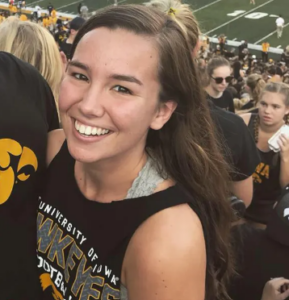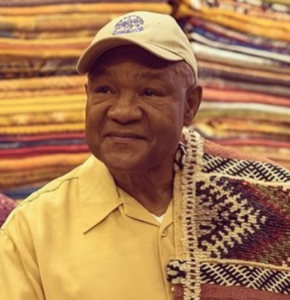The murder of Mollie Tibbetts was a horrific crime that captured national attention for many reasons. While Cristhian Bahena Rivera’s conviction brought some measure of closure to her family and the community, the case also left many unanswered questions and sparked complex debates about immigration, justice, and personal safety
Mollie’s memory continues to inspire acts of kindness and calls for change, as her family seeks to ensure that her legacy is one of compassion, not division.
In the end, Mollie Tibbetts’ story is a stark reminder of the fragility of life and the random violence that can shatter it.
Yet, through the efforts of her family and community, her life and legacy continue to influence discussions about making the world a safer, kinder place for everyone.
The Mollie Tibbetts case serves as a powerful example of how modern technology can aid in the pursuit of justice. Surveillance footage, in particular, has proven to be a game-changer in many criminal cases, providing investigators with leads that might otherwise go unnoticed.
In this case, the footage from a security camera allowed law enforcement to identify Cristhian Bahena Rivera as a suspect, shifting the investigation from a missing person case to a homicide. His eventual confession, combined with the physical evidence and the surveillance footage, resulted in his conviction for the murder of Mollie Tibbetts.

Also Read: Adrian Newey of Red Bull Discusses His Future in F1, Departure News, Career and More
Table of Contents
Mollie Tibbetts: What Happened To Her?
The Disappearance of Mollie Tibbetts
Mollie Tibbetts, a bright and well-loved 20-year-old student at the University of Iowa, was last seen alive on the evening of July 18, 2018, in her hometown of Brooklyn, Iowa.1
Mollie had been on one of her routine evening jogs when she vanished without a trace, triggering a massive search operation across the state.
Her family reported her missing after she failed to return home that night, and over the next few days, authorities, volunteers, and search teams scoured the area, hoping to find any clue that would lead them to her.
Brooklyn, a small town of fewer than 2,000 residents, was not the kind of place where violent crime was common.
The tight-knit community rallied together, hoping against hope that Mollie would be found safe. The search soon extended beyond local efforts, gaining national attention as media outlets began covering the case extensively.
Posters of Mollie’s face appeared everywhere, from local shops to social media, and her family pleaded for her safe return.
As days turned into weeks, the lack of progress left investigators grasping for leads. The case was starting to grow cold, despite massive media coverage and a flurry of tips.
But the turning point came when investigators obtained critical footage from a local surveillance camera that captured Mollie’s final moments. This footage would eventually lead them to the man responsible for her death: Cristhian Bahena Rivera.

Cristhian Bahena Rivera: Who Is He?
The Man Behind the Crime
Cristhian Bahena Rivera, a Mexican national, worked as a farmhand at Yarrabee Farms, located just a few miles from where Mollie was last seen.2
Rivera had been living in the United States illegally for several years and kept a low profile, avoiding any trouble with the law before Mollie’s disappearance. He resided in a nearby trailer park and was mostly unknown to the public until the day his name became synonymous with the brutal crime.
After weeks of intense investigation, authorities discovered surveillance footage from a homeowner’s security camera along Mollie’s jogging route. The footage showed a black Chevrolet Malibu repeatedly passing by Mollie as she jogged, leading law enforcement to track down the owner of the vehicle—Cristhian Bahena Rivera.
When questioned by police, Rivera initially denied any involvement, but after several hours of interrogation, he confessed to abducting and murdering Mollie Tibbetts.
According to Rivera’s statement, he followed Mollie in his car, got out, and ran alongside her. When she threatened to call the police, he “blacked out,” claiming he could not recall what happened next. He later found her bleeding in the trunk of his car and panicked, eventually driving to a cornfield where he disposed of her body.
Rivera led authorities to the location of Mollie’s body, buried under corn stalks in a remote area of Poweshiek County, about 10 miles from her hometown.

A Trial That Shocked the Nation
The arrest of Cristhian Bahena Rivera sent shockwaves through the nation, not only because of the brutal nature of the crime but also due to the political undertones it carried. The fact that Rivera was an undocumented immigrant fueled national debate over immigration policy and border security.
Some political figures, including then-President Donald Trump, seized on the case to highlight what they saw as failures in the immigration system. For others, the focus remained squarely on the loss of an innocent life.
Rivera’s trial was delayed several times, but when it finally took place in 2021, it attracted widespread media coverage. The prosecution presented overwhelming evidence, including Rivera’s confession, GPS data from his phone, and DNA evidence that linked Mollie’s blood to the trunk of Rivera’s car.
Although Rivera attempted to retract his confession, claiming he was coerced by investigators, the jury ultimately found him guilty of first-degree murder in May 2021.
During the trial, Rivera’s defense team introduced a surprising twist: an alternate theory involving two masked men who allegedly forced Rivera to participate in Mollie’s abduction and murder. However, this theory was met with skepticism, and the jury rejected it, convicting Rivera of the crime. Rivera was sentenced to life in prison without the possibility of parole.

Mollie Tibbetts: Unanswered Questions and Lingering Doubts
Despite Rivera’s conviction, questions still linger about the events leading up to Mollie Tibbetts’ murder.3
Rivera’s claim that he “blacked out” during the attack remains a point of confusion, raising doubts about his state of mind at the time of the crime. Was it a moment of rage or fear that led him to kill, or was there more to the story?
Furthermore, Rivera’s late-stage introduction of the two masked men, although not taken seriously by the jury, raised concerns about the completeness of the investigation.
Rivera’s defense argued that law enforcement was too focused on him as a suspect and may have overlooked other possible leads or evidence. Some critics of the investigation speculated that law enforcement, under immense pressure to solve the case quickly, may have cut corners or ignored alternative explanations.
However, the prosecution’s evidence was deemed sufficient to convince the jury of Rivera’s guilt beyond a reasonable doubt. Mollie’s family, though devastated by her loss, expressed relief that justice had been served. Still, the unanswered questions and Rivera’s inconsistent statements leave a cloud of ambiguity surrounding the case.

Also Read: Jose Mourinho Aims for Fenerbahce to Sign Barcelona Star, Transfer News and More
Mollie Tibbetts’ Legacy and the Impact on Society
- Mollie Tibbetts’ murder was not only a personal tragedy for her family but also a national one that spurred debates about issues like safety, immigration, and justice.
- Mollie’s parents have been vocal about their desire for their daughter’s memory to be preserved, not through divisive rhetoric but through acts of kindness, compassion, and community.
- Her father, Rob Tibbetts, has spoken publicly against using Mollie’s death to justify anti-immigrant policies.
- In a powerful op-ed published in The Des Moines Register, Rob Tibbetts wrote that his daughter’s life should not be “reduced to a pawn” in the political debate over immigration.
- He reminded the public that the tragedy was about the loss of a beloved young woman, not about the political status of the man convicted of her murder.
- The case also highlighted concerns about personal safety, particularly for women. Mollie’s murder occurred while she was engaging in an activity that many people do regularly—going for a jog in their own neighborhood.
- This fueled conversations about the vulnerability women often feel in public spaces and the importance of addressing issues like stalking and harassment.
- In the aftermath of Mollie’s death, several safety initiatives were proposed, including better surveillance and improved communication between local law enforcement and immigrant communities.
- The case also prompted discussions on how to prevent violence against women and how to support survivors of violence more effectively.
The Confession: Hours of Interrogation Lead to a Breakthrough
After authorities identified Cristhian Bahena Rivera as a suspect, they brought him in for questioning. Initially, Rivera denied any involvement in Mollie Tibbetts’ disappearance. For hours, he withstood questioning and provided no significant information to the investigators.
However, the dynamic of the interrogation shifted when investigators presented him with the surveillance footage.
Faced with the evidence that placed him at the scene, Bahena Rivera eventually broke down and confessed to the crime. He admitted that he had followed Mollie as she jogged, and after approaching her, an altercation ensued, culminating in him blacking out.
He claimed that when he regained consciousness, he found Mollie’s body in the trunk of his car and proceeded to hide it in a cornfield. Following his confession, he led the authorities to her remains, which were recovered a few days later.

Mollie Tibbetts: Critical Role of Surveillance Footage in the Case
The case of Mollie Tibbetts, a 20-year-old University of Iowa student who was reported missing in July 2018, gained widespread attention.
It was a case that started as a missing person investigation but soon turned into a homicide case, largely due to the critical evidence gathered from surveillance footage.
This footage not only led to the arrest of Cristhian Bahena Rivera, a farmworker, but also played a significant role in his conviction.
How Surveillance Footage Changed the Direction of the Case
Initially, Mollie Tibbetts’ disappearance baffled investigators. She had gone for a jog on the evening of July 18, 2018, in her hometown of Brooklyn, Iowa, but never returned.
For weeks, investigators followed numerous leads that seemed to go nowhere, frustrating both law enforcement and the community. However, the breakthrough came when investigators obtained surveillance footage from a local resident’s security camera.
This footage showed a black Chevy Malibu repeatedly passing by as Mollie jogged. After careful analysis, investigators were able to trace the vehicle back to Cristhian Bahena Rivera. Rivera lived and worked nearby, and the surveillance footage placed him in the vicinity of Mollie Tibbetts at the time of her disappearance.
The turning point in the investigation came when this critical piece of evidence shifted the focus from a missing person case to a homicide investigation.
Surveillance Footage: A Silent Witness
Surveillance cameras have become essential tools in modern criminal investigations, capturing events that would otherwise go unnoticed.
In the case of Mollie Tibbetts, the camera didn’t capture the crime itself, but it recorded enough clues to link Bahena Rivera to her abduction and murder.
The footage, which showed Rivera’s car following Mollie, became the silent witness that prosecutors needed to tie him to the scene. Even though there were no direct eyewitnesses, this video evidence placed Rivera in close proximity to the victim during her final moments.
With no alibi, the footage served as the foundation of the case against him, illustrating how technology can be an indispensable ally in solving criminal cases.
Also Read: Pete Alonso Trade News: Astros Exploring Deal for the Star Slugger, Fishing and More




